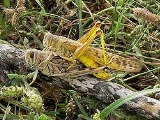
Locust
Overview
Locusts are the swarm
ing phase of short-horned grasshopper
s of the family Acrididae
. These are species that can breed rapidly under suitable conditions and subsequently become gregarious and migratory. They form bands as nymphs
and swarms as adults—both of which can travel great distances, rapidly stripping fields and greatly damaging crops.
The origin and apparent extinction
of certain species of locust – some of which reached 6 inches (15.2 cm) in length – are unclear.
Locusts are an edible insect
and are considered a delicacy in some countries and throughout history.
Though the female and the male look alike, they can be distinguished by looking at the end of their abdomens.
Swarm
Swarm behaviour, or swarming, is a collective behaviour exhibited by animals of similar size which aggregate together, perhaps milling about the same spot or perhaps moving en masse or migrating in some direction. As a term, swarming is applied particularly to insects, but can also be applied to...
ing phase of short-horned grasshopper
Grasshopper
The grasshopper is an insect of the suborder Caelifera in the order Orthoptera. To distinguish it from bush crickets or katydids, it is sometimes referred to as the short-horned grasshopper...
s of the family Acrididae
Acrididae
The Acrididae are the predominant family of grasshoppers, comprising some 10,000 of the 11,000 species of the entire suborder Caelifera. The Acrididae are best known because all locusts are of the Acrididae. The subfamily Oedipodinae is sometimes classified as a distinct family Oedipodidae in the...
. These are species that can breed rapidly under suitable conditions and subsequently become gregarious and migratory. They form bands as nymphs
Nymph (biology)
In biology, a nymph is the immature form of some invertebrates, particularly insects, which undergoes gradual metamorphosis before reaching its adult stage. Unlike a typical larva, a nymph's overall form already resembles that of the adult. In addition, while a nymph moults it never enters a...
and swarms as adults—both of which can travel great distances, rapidly stripping fields and greatly damaging crops.
The origin and apparent extinction
Extinction
In biology and ecology, extinction is the end of an organism or of a group of organisms , normally a species. The moment of extinction is generally considered to be the death of the last individual of the species, although the capacity to breed and recover may have been lost before this point...
of certain species of locust – some of which reached 6 inches (15.2 cm) in length – are unclear.
Locusts are an edible insect
Entomophagy
Entomophagy is the consumption of insects as food. Insects are eaten by many animals, but the term is generally used to refer to human consumption of insects; animals that eat insects are known as insectivores...
and are considered a delicacy in some countries and throughout history.
- Desert locustDesert locustPlagues of the desert locust have threatened agricultural production in Africa, the Middle East, and Asia for centuries. The livelihood of at least one-tenth of the world’s human population can be affected by this voracious insect...
(Schistocerca gregaria), probably the best known owing to its very wide distribution (North AfricaNorth AfricaNorth Africa or Northern Africa is the northernmost region of the African continent, linked by the Sahara to Sub-Saharan Africa. Geopolitically, the United Nations definition of Northern Africa includes eight countries or territories; Algeria, Egypt, Libya, Morocco, South Sudan, Sudan, Tunisia, and...
, Middle EastMiddle EastThe Middle East is a region that encompasses Western Asia and Northern Africa. It is often used as a synonym for Near East, in opposition to Far East...
, and Indian subcontinentIndian subcontinentThe Indian subcontinent, also Indian Subcontinent, Indo-Pak Subcontinent or South Asian Subcontinent is a region of the Asian continent on the Indian tectonic plate from the Hindu Kush or Hindu Koh, Himalayas and including the Kuen Lun and Karakoram ranges, forming a land mass which extends...
) and its ability to migrate very widely. - Migratory locustMigratory locustThe migratory locust is the most widespread locust species, and the only species in the genus Locusta. It occurs throughout Africa, Asia, Australia and New Zealand. It used to be common in Europe but has now become rare there...
(Locusta migratoria) - Red locustRed locustThe Red Locust is a large grasshopper species found south of the Sahara in Africa. Its name refers to the colour of its hindwings. It is sometimes called the Criquet nomade in French, due to its nomadic movements in the dry season.-Adults:...
(Nomadracis septemfasciata) - Australian plague locustAustralian plague locustThe Australian plague locust is a native Australian insect in the family Acrididae and a significant agricultural pest....
(Chortoicetes terminifera) - American desert locust (SchistocercaSchistocercaSchistocerca, commonly called bird grasshoppers, is a genus of grasshoppers, many of which swarm as locusts. The best known species is probably the Desert Locust...
americana) - Brown locustBrown locustThe brown locust, Locustana pardalina, is a medium-sized small locust species found in Southern Africa and shows classic gregarious behaviour with phase polymorphism) on crowding.-Biology:...
(Locustana pardalina) - Moroccan locust (Dociostaurus maroccanusDociostaurus maroccanusDociostaurus maroccanus, commonly known as the Moroccan locust, is a grasshopper in the insect family Acrididae. It is found in northern Africa, southern and eastern Europe and western Asia...
) - Rocky Mountain locustRocky Mountain locustThe Rocky Mountain locust was the locust species that ranged through almost the entire western half of the United States until the end of the 19th century...
(Melanoplus spretus) in North AmericaNorth AmericaNorth America is a continent wholly within the Northern Hemisphere and almost wholly within the Western Hemisphere. It is also considered a northern subcontinent of the Americas...
had some of the largest recorded swarms, but died out in the late 19th century.
Though the female and the male look alike, they can be distinguished by looking at the end of their abdomens.

